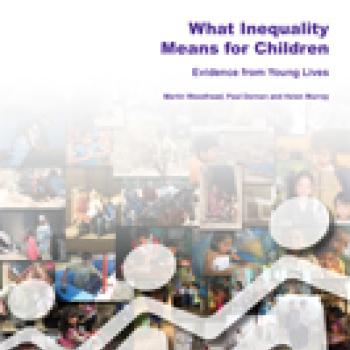
Our starting point for this paper is that child poverty and inequality are the expression of the political, economic and cultural forces that structure societies – and children’s lives – in terms of the distribution of resources and opportunities in ways that align, to a greater or lesser degree, with ethnicity or caste, religion, gender, urban/rural location, age and generation, etc. We understand inequality as covering a broad spectrum of differences in children’s household circumstances and in their outcomes and opportunities, linked to ethnicity, gender, urban/rural location, etc.
Our research finds that the most disadvantaged households and children are most vulnerable to adversities and have least resources to overcome them. We see how ways inequality undermines the development of human potential, with children from disadvantaged families quickly falling behind in terms of early learning and other outcomes.
The paper contains 8 key messages:
Message 1: Inequalities in children’s development originate in multiple disadvantages, which compound to affect children’s long-term outcomes.
Message 2: Inequalities undermine the development of human potential, and children from disadvantaged families quickly fall behind.
Message 3: In Young Lives countries, gender differences become more significant as children get older, but boys are not always advantaged over girls.
Message 4: Early malnutrition has serious, long-term consequences for children’s development (both physical and cognitive), but there is also evidence that some children may recover and ‘catch up’.
Message 5: Inequalities open up during middle and later childhood, as children grow up.
Message 6: How children feel about themselves and their well-being is both a major indicator of inequality and also a channel for the transmission of poverty.
Message 7: Education is regarded by both adults and children as having the potential to transform their lives, but doesn’t always compensate for disadvantage and may reinforce differences between children.
Message 8: Social protection programmes can reduce disadvantage, but impacts are often complex, some may be unintended and they may not always benefit children.
We conclude that since inequalities are multidimensional, so too must be the response. Equitable growth policies, education and health services, underpinned by effective social protection, all have a role to play.
The paper synthesises research carried out by the Young Lives team over the past three years. It was initially written for a consultation coordinated by UN Women and UNICEF to review progress on the Millennium Development Goals and to discuss the options for ensuring that inequalities are effectively addressed in a new development framework after 2015.

Our starting point for this paper is that child poverty and inequality are the expression of the political, economic and cultural forces that structure societies – and children’s lives – in terms of the distribution of resources and opportunities in ways that align, to a greater or lesser degree, with ethnicity or caste, religion, gender, urban/rural location, age and generation, etc. We understand inequality as covering a broad spectrum of differences in children’s household circumstances and in their outcomes and opportunities, linked to ethnicity, gender, urban/rural location, etc.
Our research finds that the most disadvantaged households and children are most vulnerable to adversities and have least resources to overcome them. We see how ways inequality undermines the development of human potential, with children from disadvantaged families quickly falling behind in terms of early learning and other outcomes.
The paper contains 8 key messages:
Message 1: Inequalities in children’s development originate in multiple disadvantages, which compound to affect children’s long-term outcomes.
Message 2: Inequalities undermine the development of human potential, and children from disadvantaged families quickly fall behind.
Message 3: In Young Lives countries, gender differences become more significant as children get older, but boys are not always advantaged over girls.
Message 4: Early malnutrition has serious, long-term consequences for children’s development (both physical and cognitive), but there is also evidence that some children may recover and ‘catch up’.
Message 5: Inequalities open up during middle and later childhood, as children grow up.
Message 6: How children feel about themselves and their well-being is both a major indicator of inequality and also a channel for the transmission of poverty.
Message 7: Education is regarded by both adults and children as having the potential to transform their lives, but doesn’t always compensate for disadvantage and may reinforce differences between children.
Message 8: Social protection programmes can reduce disadvantage, but impacts are often complex, some may be unintended and they may not always benefit children.
We conclude that since inequalities are multidimensional, so too must be the response. Equitable growth policies, education and health services, underpinned by effective social protection, all have a role to play.
The paper synthesises research carried out by the Young Lives team over the past three years. It was initially written for a consultation coordinated by UN Women and UNICEF to review progress on the Millennium Development Goals and to discuss the options for ensuring that inequalities are effectively addressed in a new development framework after 2015.

